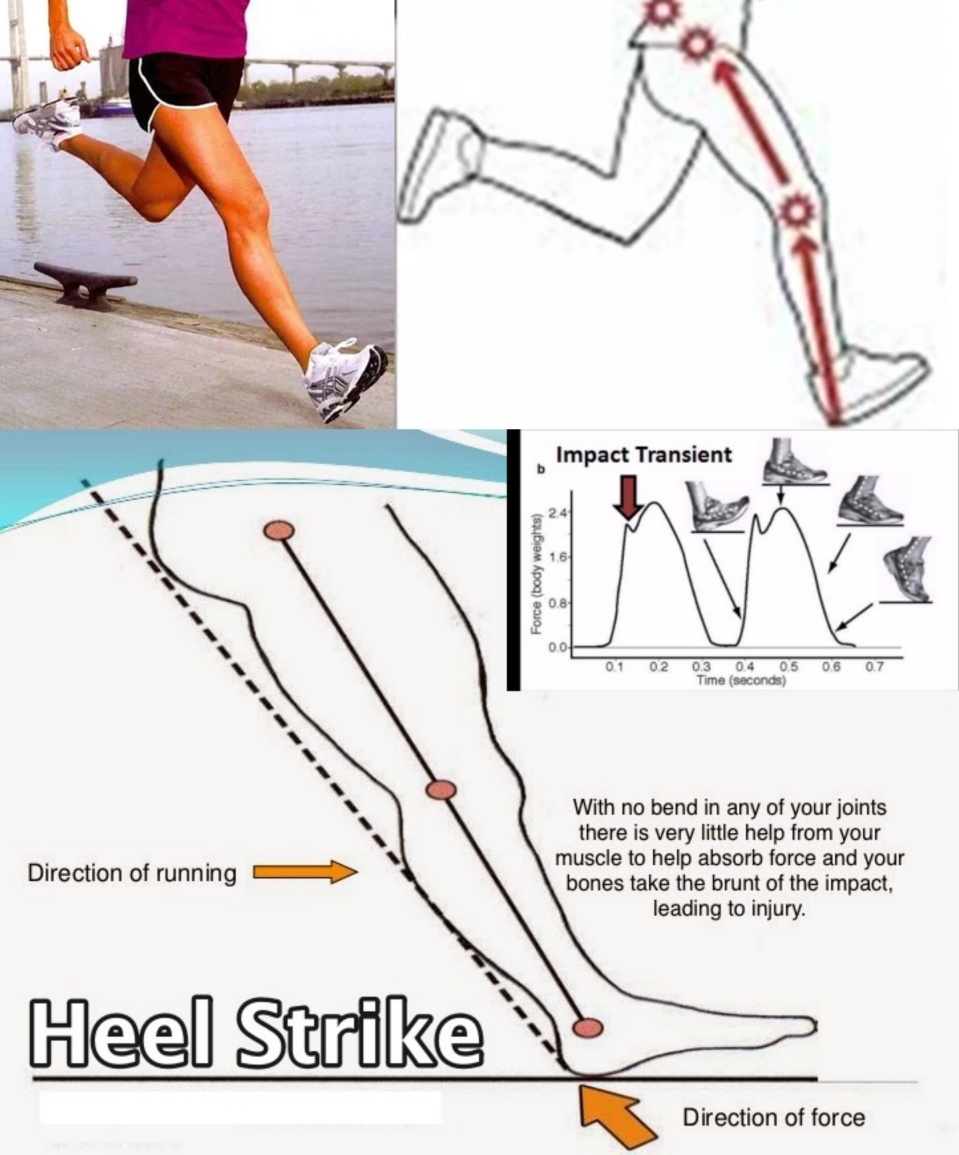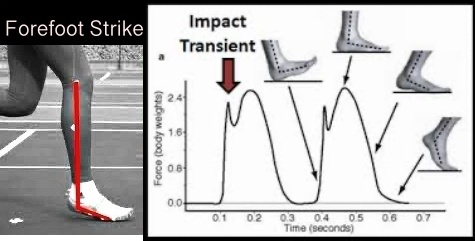Researchers have uncovered a certain impact force specifically generated in heel strike running, not in forefoot running, that is primarily responsible for lower back pain.

Research on impact mechanics have found that landing heel-first when running produces a force of 2,000N, which is equivalent to 3 times your bodyweight. This force was correlated to lower back pain near the spine, and the intensity of this force was also found to be amplified when heel strike running downhill or on uneven surfaces.
A study in the Journal Sports Medicine found that the heavy impact force produced at heel strike when running caused disc degeneration of the lower back which caused disc height reduction and lower back pain.
Lumbar (or lower back) disc degeneration is a common condition in aging adults, and is a common cause of lower back pain. The spine is made up of a column of bones called vertebrae. Between each vertebra is a shock-absorbing disc that prevents the bones from rubbing together. Inside the disc is a gel-filled center called the nucleus which is made of about 80% water. As you get older, the discs separating the spine bones slowly lose water and shrink. This causes the lower back to become very stiff and painful. These age-related changes doesn’t happen to everyone, but there are factors that can directly cause the condition, and heel strike running is certainly one of them!

The same study found that disk height reduction in heel strike running was due to the cyclic diskal and compressive loading that occurred at heel strike, and the compressive loads generated at heel strike exceeded interstitial osmotic pressure of the disk. This caused water to escape through the disk wall, thereby reducing disc height.
Even worse, the study found that as the heel strike runners increased their running distance, the conditions for disk height reduction was more pronounced!
Furthermore, the researchers speculated that disc degeneration caused by heel strike running may also reduce the shock-absorbing properties of the spine because spinal motion segments become stiff and inflexible as the discs dry out. In consequence, the loss of shock attenuation of the lower back may amplify impact that the muscles can’t absorb, making the body even more prone to injury!
How to avoid this horrible injury? Land with a forefoot strike instead of a heel strike when you run!

Forefoot running prevents impact-induced damage to the lower back because it automatically eliminates the 2,000N burst in collisional impact at landing!
This is why lower back pain virtually unheard of in not just forefoot runners, but in habitual barefoot runners because they land with a forefoot strike as its the safest way to land in the absent of under-foot cushioning.
How exactly does forefoot running eliminate back-destroying impact?
Landing with a forefoot strike when running enables the foot to land under the ankle, knee and closer to the hips (which is also the center of mass). The combined effects of these mechanical outputs reduces the over-stride angle and is the only way to prevent the body from coming to a crashing halt with the ground AND works best for preventing the impact blamed for lumbar degenerative disc reduction in runners. It’s really that simple! All it takes is changing your foot strike, from a heel strike to a forefoot strike, to avoid damaging impact altogether on the back!
Its not just the lower back that is fully protected from impact in forefoot running, the knees are also protected! Click here to read my article on how forefoot running is better for the knees than heel strike running.

If you’ve enjoyed this post on forefoot running vs heel strike running, you’ll love my Youtube Channel here, where I talk more about why forefoot running is better for injury prevention AND performance than heel strike running!
References:
Cook et al. Running shoes: their relation to running injury. Sports Med, 1990;10:1-8.
Cole et al. Spine injuries in runners: a functional approach. J Back Musculoskel Rehab, 1995; 5:317-339.
Regan JJ. Back problems in the runner. In: Hochschuler SH, ed. Spine: state of the art reviews: Philadelphia: Hanely & Belfus, 1990;4:346-350.
Reilly T., Leatt D and Troup JGD. Spinal loading during circuit weight training and running. Br J Sports Med, 1986; 20:119-124.
Slocum DB and Bowerman W. Biomechanics of running. Clin Orthop, 1962;23:37-45.
Wosh J and Voloshin AS. Low back pain: conservative treatment with artificifical shock absorbers. Arch Phys Med Rehab, 1985; 66:145-148.

If you’d like, You can show support and help keep Run Forefoot going by making a donation in any amount of your choosing:

Or, you can support Run Forefoot by shopping at the BEST Barefoot Shoe Brands, and be sure to bookmark these links 🙂
Lonowear: https://lonowear.com/?ref=cedsholh
Saguaro: https://www.saguaro.com/?ref=9bVA8fEkmDvB-I
Vibram FiveFingers: https://amzn.to/3VQLAUI
Vivobarefoot: https://amzn.to/3vycQOY
Be Lenka: https://www.tkqlhce.com/click-7600968-13947200
Xero Shoes: https://xeroshoes.com/go/Run_Forefoot
Iguaneye: https://www.iguaneye.com/?ref=8tfXVc92
Soft Star Shoes: https://shrsl.com/3mp1b
Wilding Shoes: https://bit.ly/3lIygQP
Bretta Riches
BSc Neurobiology; MSc Biomechanics candidate, ultra minimalist runner & founder of RunForefoot. I was a heel striker, always injured. I was inspired by the great Tirunesh Dibaba to try forefoot running. Now, I'm injury free. This is why I launched Run Forefoot, to advocate the health & performance benefits of forefoot running and to raise awareness on the dangers of heel striking, because the world needs to know.
Latest posts by Bretta Riches (see all)
- Can You Run In Barefoot Shoes? Yes, But DON’T Heel Strike! - 21/07/2024
- Why Cushioned Running Shoes Are Really Bad for Your Feet - 19/07/2024
- Do Cushioned Running Shoes Cause Injuries? - 17/07/2024



